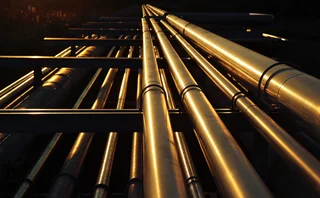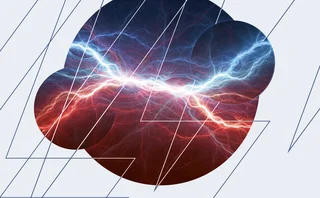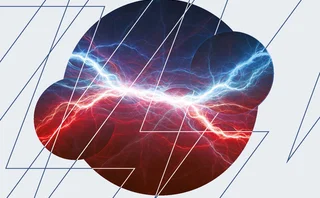
Paying the piper
The Nord Stream pipeline, planned to come online in 2011, will be vital to help Europe meet its future gas demands. However, financing any infrastructure project in the current climate is difficult. Roderick Bruce looks at the challenges facing Nord Stream
EU-27 gas import demand is forecast to rise by 52% from 285 billion cubic metres (bcm) in 2005 to around 433bcm by 2020, according to the EU's Directorate General for Transport and Energy (DG Tren).
Some 43% of 2020 EU demand is expected to be supplied from Russia, according to Gazprom, with the cross-Baltic Nord Stream pipeline playing a vital role. In fact, Nord Stream, combined with the trans-Turkey Nabucco pipeline, is expected to make up 60% of the rise in European demand to 2020.
"These pipeline projects are absolutely essential if we want to ensure supply security for Europe," said Nord Stream chairman and former German chancellor Gerhard Schroder at a conference in Geneva in March.
The 1,220km, EUR7.4 billion ($9.6 billion) Nord Stream undersea pipeline across the Baltic will deliver up to 55bcm of gas per year (bcm/y) and is on target to come online in 2011.
Ominously, the global credit crisis and turmoil in the financial markets has made the funding of major energy infrastructure projects more difficult, with most oil and gas producers and European utilities scaling back on their capital expenditure. However, despite the gloomy picture in the global economy and financial markets, banks and other financial institutions are keen to fund long-term, large-scale energy projects such as pipelines - but only if shareholders are robust and the revenue stream is guaranteed.
The future of the 3,300km, EUR7.9 billion 33bcm/y Turkey to Austria Nabucco pipeline is rather less certain than that of Nord Stream, with concerns over the availability of gas and a rival Russian-backed project, known as South Stream, casting doubts on its viability.
Plumbing the depths
The Nord Stream project, a joint venture backed by Russia's Gazprom (with a controlling 51% stake), German chemical firm BASF/Wintershall (with a 20% stake), German utility E.ON Ruhrgas (20%) and Dutch gas infrastructure firm Gasunie (9%), was conceived in 1997, with a solid proposal first presented in 2005.
The fact that Nord Stream is years ahead of the next most advanced similar project, the Nabucco pipeline, has proved to be a double-edged sword: it avoided financing concerns brought about by the intensification of the credit crunch in 2008, but had to buy steel and other construction commodities for its pipes when commodity markets were in the midst of a record price bull run.
Nord Stream began the tender process for the steel to make the first of its two constituent pipes in November 2006. 75% of the line is being produced by Germany's Europipe, with 25% produced by Russia's OMK. Nord Stream already has 400km of pipe in its stock yards - equivalent to a third of the pipeline's length. This was followed in early 2007 with the tender process for the lay barge that installs the pipe along the sea bed. The barge and construction contracts are with Italy's Saipem, part of Eni.
"It was very important for us to capture scarce capacity and resources, which is why we tendered as early as we could," says Nord Stream CFO Paul Corcoran. "At the time the oil price was much higher and there was a lot of competition - there are only three barges in the world that can handle a pipe of our size, and there are only six steel mills that can produce the pipe of the size and quality we need."
Nord Stream's dual-pipe format and the timing of the phased construction have therefore been fortunate in terms of costs. Corcoran says that while they were locked into the high steel prices at the time of tendering for the first line, these costs will now be offset when tendering for the second. "Within the EUR7.4 billion total cost estimate we budgeted for a 20% steel cost increase between the first and the second line, but we're in a very different world now," says Corcoran, who didn't share his estimates on how much steel costs have fallen. "We'll wait and see what the bids bring us, but we're in a very different competitive environment. The steel for the second line will be substantially cheaper than the first line and therefore our budget has an extra contingency there," he says.
The initial expenditure of the project has all been funded by the shareholders, who have contributed 30% of the total costs upfront on a pro-rata basis per shareholding. Corcoran says that this initial upfront funding has been vital in keeping the project on course to deliver first gas in October 2011, and Nord Stream has now initiated the process to gain project financing for the other 70%.
Three investment banks are acting as financial advisors to Nord Stream: Societe Generale, Royal Bank of Scotland and Dresdner Kleinwort (now Commerzbank).
However, even before any tendering processes began, SG assisted in the development of the gas transport agreement between Gazprom Export and Nord Stream, an agreement that covers the full capacity of the pipeline for a period of more than 20 years. This means that any project finance lenders are only exposed to transport cost rather than the volatile price of gas itself, making the project more attractive.
"It's a very long-term send or pay contract, so there's no market risks for the company or for the lenders," says Stephen Craen, co-head of EMEA energy project finance at Societe Generale. "Gazprom has committed to pay for the capacity from day one even if they do not require it all initially."
Projecting finance
With EUR1.4 billion contributed by robust shareholders, and a strong revenue stream in place, Nord Stream is hoping to attract around EUR6 billion in debt financing, in two EUR3 billion tranches. The company hopes to go to the market sometime in the second quarter of 2009. Corcoran says that the structure of the financing has changed significantly as the credit crunch started to bite. "Two years ago we had lots of offers from banks for big underwriting amounts, with some in a position to offer EUR1billion in financing with a view to finding a secondary market for that debt," says Corcoran. "The financial crisis means that is no longer the case. Banks are now focusing on their internal risk profile, so we'll expect to now see only the direct involvement of banks with no pass-through."
SG's Craen says that it used to be common for banks to offer such a large sum for project finance deals, as they would be confident of selling debt into a liquid secondary market. But with the drying up of liquidity and risk appetite due to the banking crisis, banks are no longer willing to take the risk of not being able to sell on the debt at an acceptable price.
Nord Stream is therefore likely to be 'club' financed by a group of 20 to 25 banks, each contributing a smaller amount of funding and each given the title of mandated lead arranger. Craen says that because of their sheer scale, club financing has been a growing trend for energy projects for years, intensified by the credit crisis.
A final, vital aspect of the financing is the role played by export credit agencies (ECAs). These are state-backed groups that offer a range of credit insurance products to support exports from their respective countries. In the case of Nord Stream, one EUR3 billion tranche of lending will be guaranteed by ECAs, while the other will be pure non-recourse financing.
The two ECAs involved are Italy's SACE, due to the involvement of Saipem and Italian steel mills, and Germany's Hermes, due to the role of Europipe. The guarantees provided by ECAs therefore make that tranche more attractive to banks, as there is less risk involved.
"The syndicated loan market is just not deep enough for many of the big ticket infrastructure projects, so ECAs can supplement debt capacity and make the project more commercially attractive to individual sponsors," says Andrew Davison, vice president and senior credit officer in Moody's Project Finance Group. "ECAs' insurance allows banks to lend against the credit quality of the ECAs, and that credit enhances a project against commercial or political risk."
Nord Stream's Corcoran is therefore bullish that the project will have no financial problems and that it will meet its construction deadlines. "There's a fundamental commercial commitment from the partners, and from a project finance perspective the key question is: is there a solid income stream that will repay the debt? In our case the clear answer is yes," he says.
Blocked pipe
While there is much bullishness surrounding Nord Stream, people are less certain about rival pipeline Nabucco, which could suffer from competition from both Nord Stream and South Stream. Gazprom and Eni's joint-venture 30bcm/y South Stream pipeline, which will bring Russian gas to Europe via Bulgaria, casts a shadow on Nabucco. Saipem is still in the process of carrying out feasibility studies for Nabucco, which are expected to be completed in 2010, and Gazprom estimates the potential cost of the pipeline to be around EUR25 billion. Should the project receive governmental approval from transit countries and the EU, it is expected to become operational in 2015.
Like Nord Stream, Gazprom's backing of the South Stream project has given it credibility, though some question even its ability to deliver such vast amounts of new supply. "South Stream is less well positioned politically in Europe than Nabucco, but it's got a better chance of getting the gas," says Steven Wardlaw, Moscow-based partner at law firm Baker Botts. "There's always the question as to where the participants are going to get a sufficiently dependable gas flow, particularly given their future obligations."
One investor in Russia, who wished to remain anonymous, called the corporate manoeuvrings around pipelines a "quicksand"; that is likely to sink one of the projects. "Three pipelines that will transport more gas than there actually is? I don't know how it's going to happen," he says.
The contrasting prospects of Nord Stream and Nabucco have emphasised that while the financial crisis might play a role in shaping financing structures, it will not be the make or break factor in deciding a project's viability. Aside from the background politics, that decisive role will go to more traditional fundamental aspects: whether the upstream energy actually exists to fill the pipeline, and the financial credibility of the companies involved. While Nord Stream looks to be well on the way to becoming a functioning pipeline, Nabucco has some key aspects to address before it moves off the drawing board.
Only users who have a paid subscription or are part of a corporate subscription are able to print or copy content.
To access these options, along with all other subscription benefits, please contact info@risk.net or view our subscription options here: http://subscriptions.risk.net/subscribe
You are currently unable to print this content. Please contact info@risk.net to find out more.
You are currently unable to copy this content. Please contact info@risk.net to find out more.
Copyright Infopro Digital Limited. All rights reserved.
You may share this content using our article tools. Printing this content is for the sole use of the Authorised User (named subscriber), as outlined in our terms and conditions - https://www.infopro-insight.com/terms-conditions/insight-subscriptions/
If you would like to purchase additional rights please email info@risk.net
Copyright Infopro Digital Limited. All rights reserved.
You may share this content using our article tools. Copying this content is for the sole use of the Authorised User (named subscriber), as outlined in our terms and conditions - https://www.infopro-insight.com/terms-conditions/insight-subscriptions/
If you would like to purchase additional rights please email info@risk.net
More on Energy
Energy Risk Commodity Rankings 2024: markets buffeted by geopolitics and economic woes
Winners of the 2024 Commodity Rankings steeled clients to navigate competing forces
Chartis Energy50
The latest iteration of Chartis’ Energy50 ranking
Energy trade surveillance solutions 2023: market and vendor landscape
The market for energy trading surveillance solutions, though small, is expanding as specialist vendors emerge, catering to diverse geographies and market specifics. These vendors, which originate from various sectors, contribute further to the market’s…
Achieving net zero with carbon offsets: best practices and what to avoid
A survey by Risk.net and ION Commodities found that firms are wary of using carbon offsets in their net-zero strategies. While this is understandable, given the reputational risk of many offset projects, it is likely to be extremely difficult and more…
Chartis Energy50 2023
The latest iteration of Chartis' Energy50 2023 ranking and report considers the key issues in today’s energy space, and assesses the vendors operating within it
ION Commodities: spotlight on risk management trends
Energy Risk Software Rankings and awards winner’s interview: ION Commodities
Lacima’s models stand the test of major risk events
Lacima’s consistent approach between trading and risk has allowed it to dominate the enterprise risk software analytics and metrics categories for nearly a decade
2021 brings big changes to the carbon market landscape
ZE PowerGroup Inc. explores how newly launched emissions trading systems, recently established task forces, upcoming initiatives and the new US President, Joe Biden, and his administration can further the drive towards tackling the climate crisis
Most read
- Top 10 operational risks for 2024
- Japanese megabanks shun internal models as FRTB bites
- Top 10 op risks: third parties stoke cyber risk







